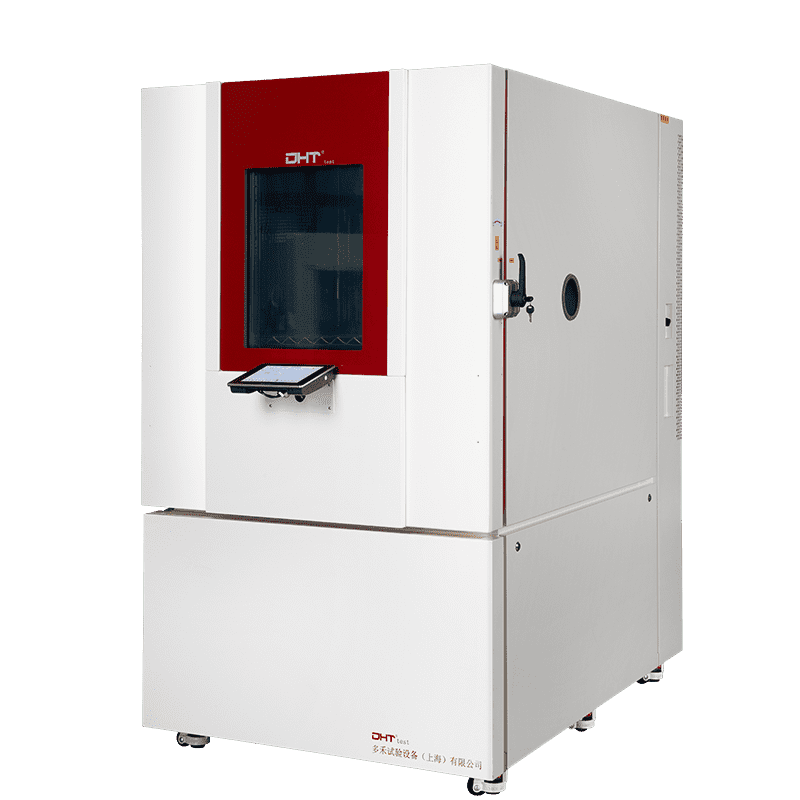What Is a Thermal Shock Chamber?
A Temperaturschockkammer is a specialized environmental test system designed to rapidly alternate test samples between high- and low-temperature zones within a very short period of time. Typically built with a two-zone or three-zone design, the chamber uses either a mechanical transfer arm or an advanced air circulation system to quickly shift samples between temperature extremes. This process effectively simulates the sudden temperature variations that products experience in real-world applications.
The core functions of a thermal shock test chamber include:
- Schneller Temperaturübergang – Achieves high-to-low or low-to-high temperature changes within seconds to minutes.
- Accelerated Stress Verification – Repeated thermal cycling exposes micro-cracks, solder joint fatigue, and seal degradation caused by thermal expansion and contraction.
- Zuverlässigkeitsprüfung – Provides predictive insights into product stability, service life, and performance under extreme operating conditions.
For the new energy vehicle (NEV) industry, these testing capabilities are crucial. Key systems such as batteries, power electronics, and drive units must consistently perform in harsh environments to ensure safety and reliability.
Applications of Thermal Shock Testing in NEV Components
Power Battery Systems
Power batteries are at the heart of NEVs, and their safety and reliability directly affect overall vehicle performance. During operation, batteries undergo frequent charge–discharge cycles and face temperature fluctuations, such as cold starts in winter or high-temperature charging in summer.
- Testing Objective: Assess the electrochemical stability, mechanical strength, and insulation performance of cells and modules under extreme thermal stress.
- Typical Application: A thermal shock test chamber can simulate rapid cycling between –40°C and +100°C or higher. Such tests reveal potential risks including micro-cracks in housing welds, separator shrinkage, tab joint fatigue, and insulation failures—critical data for structural and material optimization.
- Wert: Supports compliance with safety standards such as GB/T 31485 for traction batteries, while reducing the risk of costly product recalls.
Power Electronics (MCU, BMS, Inverters, etc.)
The electronic control system—often described as the “brain” of the NEV—comprises hundreds of components. Circuit boards, solder joints, and semiconductors are especially vulnerable to stress fatigue under rapid thermal changes.
- Testing Objective: Validate the thermal cycling reliability of printed circuit boards (PCBs), solder joints, and power modules.
- Typical Application: Temperaturschockprüfung quickly exposes latent defects such as cold solder joints, tin cracks, solder fatigue, and semiconductor degradation. Failures in a BMS motherboard, for example, could disable essential battery protection, posing significant safety risks.
- Wert: Ensures electronic controls operate with precision and stability even in climates that alternate between freezing cold and scorching heat.
Electric Motors and Drive Systems
Electric motors in NEVs operate under continuous high load, meaning windings, magnets, bearings, and seals must withstand combined thermal, mechanical, and environmental stresses.
- Testing Objective: Verify insulation endurance, magnetic stability, and seal reliability under alternating hot and cold conditions.
- Typical Application: In thermal shock chambers, motors are cycled from subzero to elevated temperatures. This reveals potential issues such as winding enamel degradation, demagnetization due to stress, and seal failures that could cause leaks.
- Wert: Guarantees that motors maintain high efficiency and durability even under long-term, extreme climate conditions.
Onboard Sensors and Electronic Components
NEVs integrate a variety of intelligent sensors and electronic devices—such as cameras, millimeter-wave radars, and temperature sensors—that are critical for vehicle safety and autonomous driving functions.
- Testing Objective: Evaluate sensor signal stability, accuracy, and responsiveness under thermal stress.
- Typical Application: By simulating conditions such as transitioning from summer heat exposure into a cold tunnel, thermal shock testing verifies whether signals remain stable without delays or drifts.
- Wert: Ensures advanced driver-assistance systems (ADAS) maintain reliable perception across diverse climate scenarios.
How to Choose the Right Thermal Shock Chamber for NEV Components
Because NEV components vary greatly in size and test requirements, selecting the right thermal shock test chamber is critical. Key factors to consider include:
- Temperature Range and Transfer Speed Ensure the chamber covers –70°C to +200°C with rapid switching capabilities, meeting the most demanding test conditions for batteries and electronics.
- Test Capacity Choose a chamber volume that accommodates your specific samples, whether battery modules, complete motors, or electronic control boards. DHT® offers multiple chamber sizes for both small-scale R&D and full-system testing.
- Accuracy and Stability Precise and repeatable control is essential for reliable results. DHT® thermal shock chambers use high-quality sensors and optimized airflow systems to guarantee uniform temperature distribution and repeatable data.
- Sicherheitsmerkmale Look for critical protections such as over-temperature cutoffs, emergency stop, power failure safeguards, and door interlocks—particularly important in high-risk battery testing.
- Technische Unterstützung A chamber purchase is not only about hardware but also about gaining a complete testing solution. Beyond supplying thermal shock chambers, DHT® provides test method consultation, maintenance training, and after-sales support to ensure efficient and effective reliability validation.
| DHT® Mini Thermal Shock Test Chamber(Two-Zone) | ||
| TemperatureChamberModel | Modell | DHTT-27-M |
| Working Room Volume | L | 27 |
| Temperaturbereich | ℃ | (Pre-heating)+180 (Pre-cooling)-65 |
| ThermaShock Range | ℃ | (-40,-50,-60)~+(+80,+120,+150) |
| Heating Rate | °C/min | 2.0~4.0 |
| CoolingRate | °C/min | 0.7~3.5 |
| Temperaturschwankung | ℃ | ±0,1~±0,5 |
| Temperature Uniformity | ℃ | 0.5~2.0 |
| Testing Mode | Lift-and-shift switching | |
| Übertragungszeit | S | <15 |
| Transfer Mode | Pneumatisch | |
| Tempearture Recovering Time | min | 5 |
| Internal Dimensions | W(mm) | 300 |
| D(mm) | 300 | |
| H(mm) | 300 | |
| External Dimensions | W(mm) | 500 |
| D(mm) | 1100 | |
| H(mm) | 1330 | |
| Cooling Mode | Luftkühlung | |
| Power Voltage | 220V±10%,50~60Hz | |
| Nennleistung | 5kW | |
Schlussfolgerung
For new energy vehicle manufacturers, selecting a high-performance and reliable thermal shock test chamber is not only essential for meeting quality certification standards but also a key strategy for enhancing market competitiveness and brand reputation.
As a specialist in environmental testing equipment, DHT® offers a wide range of thermal shock chambers, including both dual-zone and tri-zone configurations, designed to accurately meet the testing requirements of NEV components under extreme temperature variations. If you are looking for a high-performance thermal shock chamber or seeking expert guidance on testing and maintenance solutions, the DHT® professional team is ready to assist. We provide solid support for your NEV product development and quality assurance efforts.


